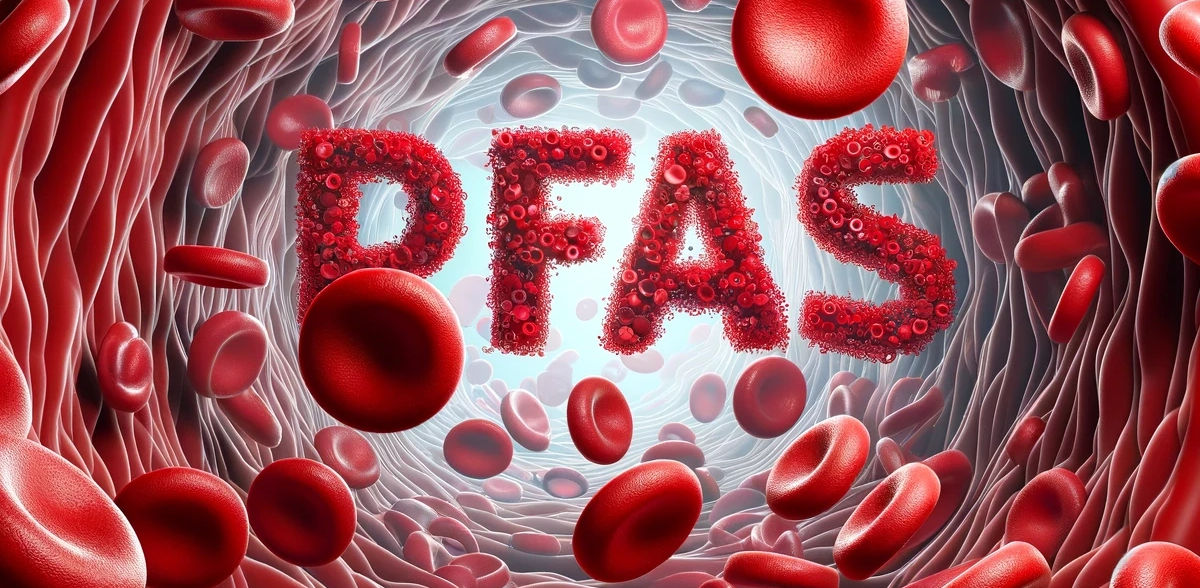PFAS in blood are ubiquitous – and they are associated with an increased risk of cardiovascular diseases
Younger people are particularly affected
Researchers at DZNE provide evidence that traces of the widely used PFAS chemicals in human blood are associated with unfavorable lipid profiles and thus with an increased risk of cardiovascular diseases. The findings are based on data from more than 2,500 adults from Bonn and the Dutch municipality of Leiderdorp. PFAS were detectable in the blood of nearly all study participants. The study results have been published in the scientific journal “Exposure and Health”.
Since their invention in the 1950s, more than 10,000 different substances from the category of per- and polyfluorinated alkyl compounds (PFAS) have been developed, according to estimates. Due to their water, fat and dirt-repellent properties, they are used in thousands of products such as cosmetics, dental floss, but also in pan coatings and fire-extinguishing foam. In addition to their basic chemical structure, PFAS have another thing in common: they are nearly non-degradable. Particularly via groundwater that they enter the human food chain.
Younger people are particularly affected
The findings of the Bonn researchers are the latest contribution to the current debate on the effect of PFAS on human health. “We see clear signs of a harmful effect of PFAS on health. And we have found that at the same PFAS concentration in the blood, the negative effects are more pronounced in younger subjects than in older ones,” says Prof. Dr. Dr. Monique Breteler, Director of Population Health Sciences at DZNE. The results of the current study also suggest that even relatively low PFAS concentrations in the blood are associated with unfavorable blood lipid profiles.
“Our data shows a statistically significant correlation between PFAS in the blood and harmful blood lipids linked to cardiovascular risk. The higher the PFAS level, the higher the concentration of these lipids. Taken strictly, this is not yet a proof that PFAS chemicals cause the unfavorable blood lipid profiles. However, the close correlation supports this suspicion. It is a strong argument for stricter regulation of PFAS in order to protect health,” says the Bonn researcher. Strikingly, PFAS could be detected in the blood of almost all test subjects. Which means you cannot escape these chemicals. “Even if we don’t see an immediate health threat for the study participants we examined, the situation is still worrying. In the long term, the increased risk may very well have a negative impact on the heart and cardiovascular system,” says Breteler.
Blood samples from Bonn and the Netherlands
The current study was based on DZNE’s “Rhineland Study” – a population-based health study in the Bonn urban area – and the so-called NEO study from the Netherlands (“Netherlands Epidemiology of Obesity study”). In this framework, researchers from DZNE collaborated with experts from the Leiden University Medical Center in the Netherlands. Blood samples from a total of more than 2,500 women and men aged between 30 and 89 were included in the analyses. For this, state-of-the-art technology was used. “The technology to analyze blood samples with the accuracy required for our research has only become available in recent years,” says DZNE scientist Elvire Landstra. She is the first author of the current publication together with a colleague from Leiden.
Most detailed study so far
The blood samples were analyzed in detail using a sophisticated method known as mass spectrometry. In their analysis, the researchers focused on three of the most widespread types of PFAS – PFOA, PFOS and PFHxS – and also determined the concentration of 224 blood lipids, metabolites and amino acids. “With this ‘untargeted approach’ – an intentionally broad approach without a preconceived target – we were able to prove the connection between the PFAS concentration and a problematic profile of fatty substances, so-called lipids. These include the well-known cholesterol and various other blood lipids that are known to be risk factors for cardiovascular disease,” says Elvire Landstra. No significant differences were found between the samples from Bonn and Leiderdorp. “Our study is the most detailed on this topic to date and the one with the largest database. Previous studies had already suggested a correlation between PFAS and unhealthy blood lipids, but this link had never been as clear as in our study.”
Future studies could focus on specific areas of the body, the Bonn researchers suggest. “We looked at the blood levels. In a next step, it would make sense to investigate the occurrence of PFAS in individual organs,” Monique Breteler says.
Original publication
Tariq O. Faquih, Elvire N. Landstra, Astrid van Hylckama Vlieg, N. Ahmad Aziz, Ruifang Li-Gao, Renée de Mutsert, Frits R. Rosendaal, Raymond Noordam, Diana van Heemst, Dennis O. Mook-Kanamori, Ko Willems van Dijk, Monique M. B. Breteler; "Per- and Polyfluoroalkyl Substances Concentrations are Associated with an Unfavorable Cardio-Metabolic Risk Profile: Findings from Two Population-Based Cohort Studies"; Exposure and Health, 2024-2-6























































